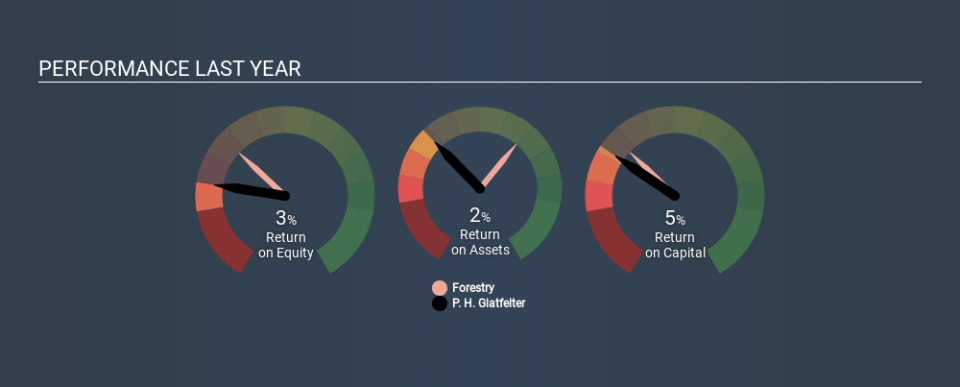Should You Worry About P. H. Glatfelter Company’s (NYSE:GLT) ROCE?

Today we'll look at P. H. Glatfelter Company (NYSE:GLT) and reflect on its potential as an investment. In particular, we'll consider its Return On Capital Employed (ROCE), as that can give us insight into how profitably the company is able to employ capital in its business.
Firstly, we'll go over how we calculate ROCE. Second, we'll look at its ROCE compared to similar companies. Finally, we'll look at how its current liabilities affect its ROCE.
Return On Capital Employed (ROCE): What is it?
ROCE measures the 'return' (pre-tax profit) a company generates from capital employed in its business. In general, businesses with a higher ROCE are usually better quality. Overall, it is a valuable metric that has its flaws. Author Edwin Whiting says to be careful when comparing the ROCE of different businesses, since 'No two businesses are exactly alike.
So, How Do We Calculate ROCE?
Analysts use this formula to calculate return on capital employed:
Return on Capital Employed = Earnings Before Interest and Tax (EBIT) ÷ (Total Assets - Current Liabilities)
Or for P. H. Glatfelter:
0.053 = US$54m ÷ (US$1.2b - US$217m) (Based on the trailing twelve months to September 2019.)
Therefore, P. H. Glatfelter has an ROCE of 5.3%.
See our latest analysis for P. H. Glatfelter
Does P. H. Glatfelter Have A Good ROCE?
ROCE can be useful when making comparisons, such as between similar companies. In this analysis, P. H. Glatfelter's ROCE appears meaningfully below the 10% average reported by the Forestry industry. This performance could be negative if sustained, as it suggests the business may underperform its industry. Separate from how P. H. Glatfelter stacks up against its industry, its ROCE in absolute terms is mediocre; relative to the returns on government bonds. Investors may wish to consider higher-performing investments.
The image below shows how P. H. Glatfelter's ROCE compares to its industry, and you can click it to see more detail on its past growth.
Remember that this metric is backwards looking - it shows what has happened in the past, and does not accurately predict the future. Companies in cyclical industries can be difficult to understand using ROCE, as returns typically look high during boom times, and low during busts. ROCE is only a point-in-time measure. Since the future is so important for investors, you should check out our free report on analyst forecasts for P. H. Glatfelter.
Do P. H. Glatfelter's Current Liabilities Skew Its ROCE?
Current liabilities are short term bills and invoices that need to be paid in 12 months or less. Due to the way ROCE is calculated, a high level of current liabilities makes a company look as though it has less capital employed, and thus can (sometimes unfairly) boost the ROCE. To check the impact of this, we calculate if a company has high current liabilities relative to its total assets.
P. H. Glatfelter has total assets of US$1.2b and current liabilities of US$217m. Therefore its current liabilities are equivalent to approximately 17% of its total assets. This is a modest level of current liabilities, which would only have a small effect on ROCE.
What We Can Learn From P. H. Glatfelter's ROCE
If P. H. Glatfelter continues to earn an uninspiring ROCE, there may be better places to invest. But note: make sure you look for a great company, not just the first idea you come across. So take a peek at this free list of interesting companies with strong recent earnings growth (and a P/E ratio below 20).
If you like to buy stocks alongside management, then you might just love this free list of companies. (Hint: insiders have been buying them).
If you spot an error that warrants correction, please contact the editor at editorial-team@simplywallst.com. This article by Simply Wall St is general in nature. It does not constitute a recommendation to buy or sell any stock, and does not take account of your objectives, or your financial situation. Simply Wall St has no position in the stocks mentioned.
We aim to bring you long-term focused research analysis driven by fundamental data. Note that our analysis may not factor in the latest price-sensitive company announcements or qualitative material. Thank you for reading.

 Yahoo Finance
Yahoo Finance 
